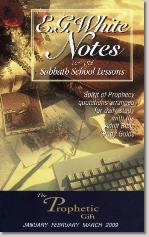|
||||||||||||||||||||
Commentary on "Interpreting the Prophetic Writings"
Day 4: Tuesday, March 10, 2009
In this lesson the author references Jeremiah 4:23-26. He states that Adventists read these texts as describing the millennium and notes that Ellen White used these texts in The Great Controversy to describe the state of the earth during the millennium. The author acknowledges that the context of this passage actually deals with the destruction of Jerusalem in 586 B.C., but states that we need to take the circumstances under which Jeremiah wrote these texts into account when interpreting them.
The author then quotes a well known passage from Ellen White which appears to condemn expending money on “bicycles and dress and other needless things”. He explains that we need to take the circumstances under which White wrote into account when interpreting passages like this. He states that White was actually dealing with the principle of good stewardship when she condemned bicycles which were expensive luxury items at the time.
Problems
It is difficult to know what to make of this lesson. It certainly is important to understand historical context when interpreting any material. However, the opening discussion of Jeremiah 4:23-26 is incomprehensible. While it is helpful to understand the historical context Jeremiah was writing in, the coming destruction of Jerusalem, none of this relates in any way to the state of the earth during the millennium. The Jeremiah passage describes a barren wasteland while every passage in the Bible dealing with the millennium describes a time of peace and abundance. It is completely unclear why anyone would think the passage in Jeremiah deals with the millennium other than the fact that Ellen White used it this way. Appreciating the historical context under which Jeremiah wrote only serves to demonstrate that Ellen White either didn’t understand this passage or simply misused it. It is unclear why the author would use this as an example of understanding historical context.
Whatever White may have meant in her passage condemning the expenditure of funds on bicycles, it demonstrates a focus which is more centered on externals then on the heart. The Bible most certainly presents principles of good stewardship, but it never condemns having nice things. Having nice things is not the issue. Ultimately it is a heart issue. You might see someone who has almost nothing and think, “They must be very spiritual”. That’s not necessarily true. It’s possible that they are very worldly and focused on gaining material things. You might see a person with a very nice car and a very nice house and think, “They must really be worldly.” However, it may be that the Lord has blessed them abundantly and they are then able to generously put large amounts of what they earn back into the mission of building the kingdom. You might think, “Well if I had that much money I would be generous too.” If you’re not generous with what you have now, you wouldn’t be generous with more. It’s not about what you have; it’s ultimately a heart issue. Whether or not someone drives a really nice car, or a bicycle, is not the issue. The issue is about what, or more specifically who, your heart is fixed on. Putting White’s comments in historical context does not change the fact that she often focused more on conformance to external standards, as set forth in her writings, then she did on issues of the heart, as set forth in scripture.
Summary
- Jeremiah 4:23-26 deals with the destruction of Jerusalem and therefore cannot be symbolic of the millennium which is marked by abundance and peace. It is unclear what the author of the lesson had in mind here other than to attempt to justify another biblical misinterpretation by Ellen White.
- The authors attempt to contextualize White’s condemnation of bicycles fails to deal with the issue of White’s frequent legalism which put conformance to standards she created above the more serious issue of who the heart is fixed on.
Copyright 2009 BibleStudiesForAdventists.com. All rights reserved. Revised March 6, 2009. This website is published by Life Assurance Ministries, Glendale, Arizona, USA, the publisher of Proclamation! Magazine. Contact email: BibleStudiesForAdventists@gmail.com.


The Sabbath School Bible Study Guide and the corresponding E.G. White Notes are published by Pacific Press Publishing Association, which is owned and operated by the Seventh-day Adventist church. The current quarter's editions are pictured above.
Official Adventist Resources
Standard Edition Study Guide Week 11
Teacher's Edition Study Guide Week 11
Easy Reading Edition Study Guide Week 11
Search the Complete Published Ellen G. White Writings
